Start your day with a traditional Japanese breakfast! With a combination of grain, healthy & omega-rich proteins, pickles, and umami flavors, it’s a wholesome breakfast that is going to satisfy and energize you. Learn how to make a Japanese breakfast at home today!
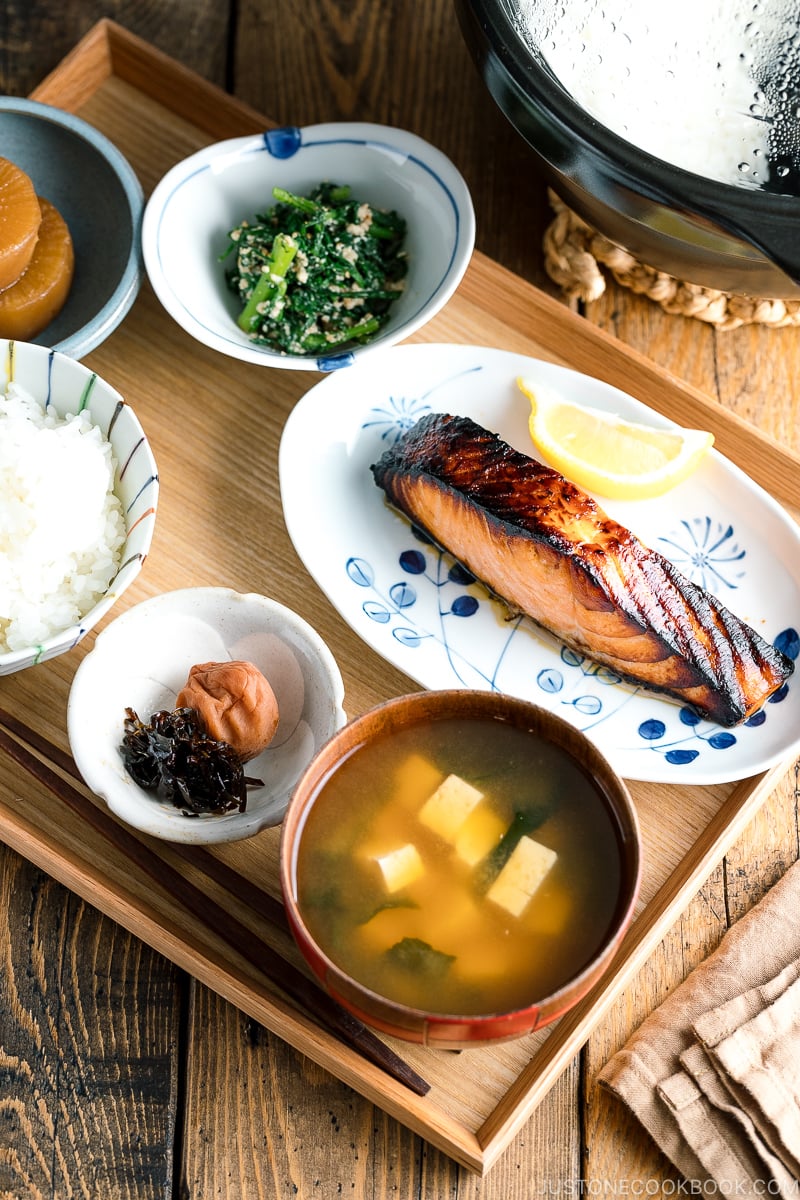
What do the Japanese eat for breakfast? My answer is always this: The Japanese, like most people, eat a great variety of things for breakfast. But when comes to traditional Japanese breakfast, it is a whole different level of experience.
At the table, you’ll find a spread of steamed rice, miso soup, a protein, pickles, and several side dishes. It is the typical breakfast that my parents, along with many Japanese of their generations, grew up with and still eat almost every morning.
If you’re used to a quick bowl of cereal or toast in the morning, you may exclaim this looks more like a lunch or dinner! It does look that way, especially in the modern days when we have little to zero time to even enjoy a decent breakfast. More so, a breakfast that looks like a full meal, complete in both nutrients and presentation.
Warm rice, salted salmon, miso soup and seaweed. There’s really no better breakfast in the world!
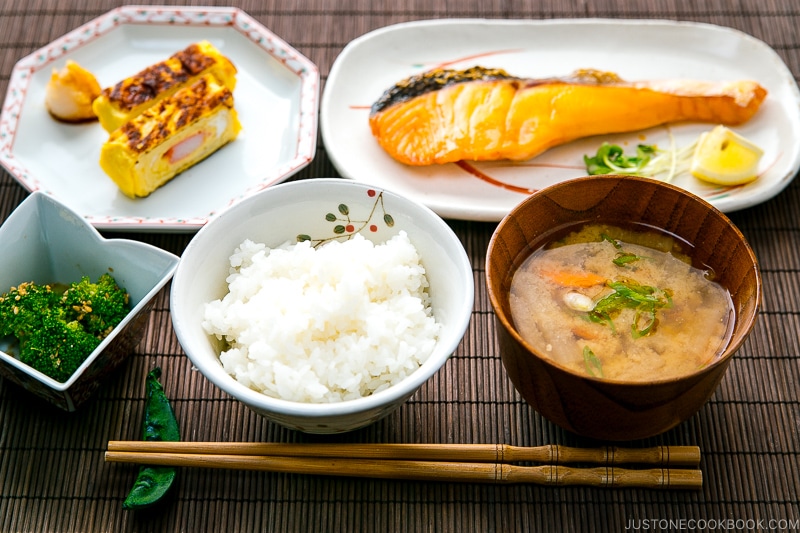
The Concept of a Traditional Japanese Breakfast
The Japanese have always placed great importance on food. Drawing on the eastern philosophy that our bodies rise together with the sun, we should start the first meal of our day with foods that are nutritionally well-rounded. A good breakfast helps to fuel our energy, regulate blood pressure and prepare us mentally and physically for the day.
Central to Japanese life values, the traditional Japanese breakfast also illustrates the concept of balance. You can see a thoughtful composition of color, taste, aroma, and texture in the meal itself.
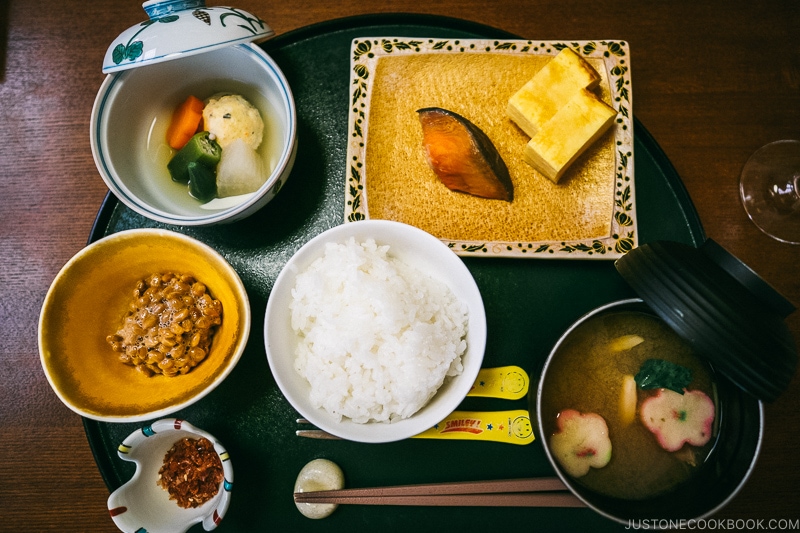
I like to think of it as a sized down, simplified version of ichiju sansai (一汁三菜), the foundation of Japanese meal that consists of one soup, three dishes, and rice. The breakfast itself can be hearty but not overly filling. Unlike lunch and dinner, we would serve dishes that are lighter on the palate and not anything heavy, deep-fried, or rich. They are designed to stimulate the appetites and not weighing one’s down.
Let’s take a quick look at the components:
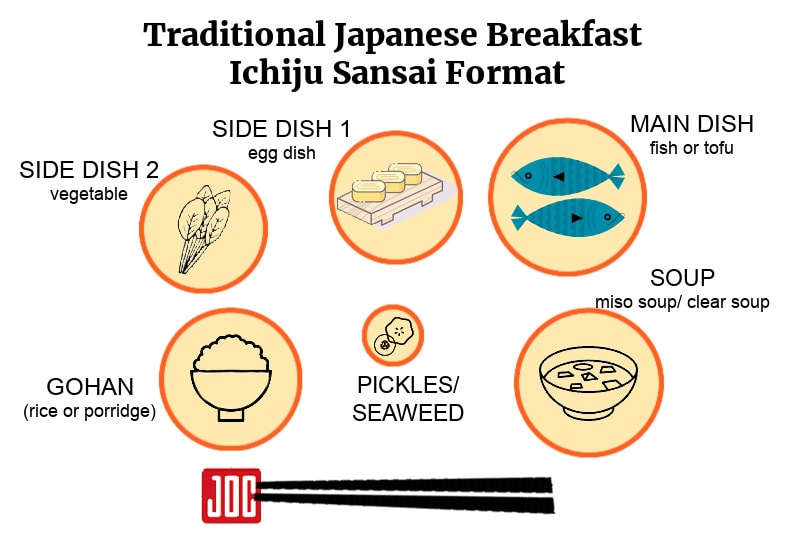
- Gohan (ご飯) – a bowl of steamed rice or porridge
- Shiru (汁) – a bowl of miso soup
- Okazu (おかず) – main dish and 2 side dishes composed of vegetables, tofu or fish
- Kouno mono (香の物) – a small plate of pickled vegetables
An example of a common Japanese breakfast menu:
- Steamed rice
- Miso soup
- Grilled fish
- Egg dish (tamagoyaki, onsen tamago, raw egg, fried egg)
- Vegetable side dish
- Pickled vegetable
- Seaweed
- Natto
There are carbohydrates, protein, fiber, omega 3, calcium, iron, vitamins, probiotics, all in one meal! Isn’t this the most satisfying breakfast one could start the day with?
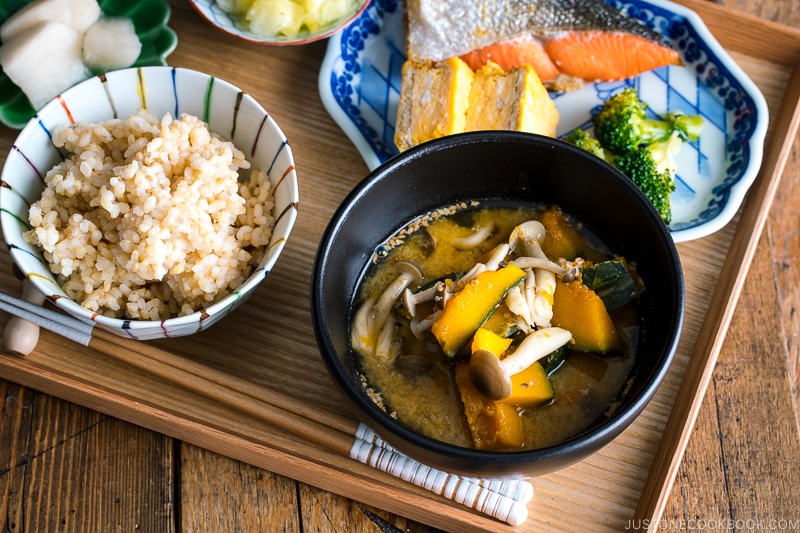
How to Make Traditional Japanese Breakfast At Home
Before you start, you may be asking how is it possible to throw such an elaborate spread of dishes at the breakfast table, especially when you’re in a hurry. Don’t worry, it is not as tricky as you think!
Japanese families do not spend the wee hours just to cook everything from scratch. We take shortcuts too!
I have three simple tips for you:
- Think customization and improvisation
- Make good use of leftovers and freezer foods
- Feel free to leave out or substitute any ingredients that work for you
Thanks to the previous night’s dinner, we just need to decide what works for breakfast and reheat leftovers, and any made-ahead pickles or blanched vegetables.
Following the structure and my tips and recipes, you can definitely put together a traditional Japanese breakfast at home with ease and speed!
Rice (Gohan) ご飯
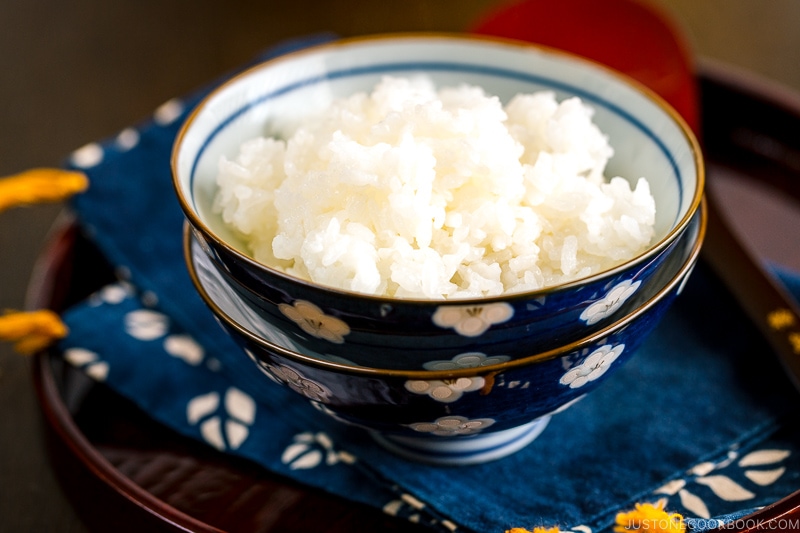
The most essential component of a Japanese breakfast is rice. Traditionally, steamed rice would be served plain. As the main source of carbohydrates, rice provides a toothsome, warmth, filling, and neutral counterpoint to the accompanying dishes.
Soup 汁物
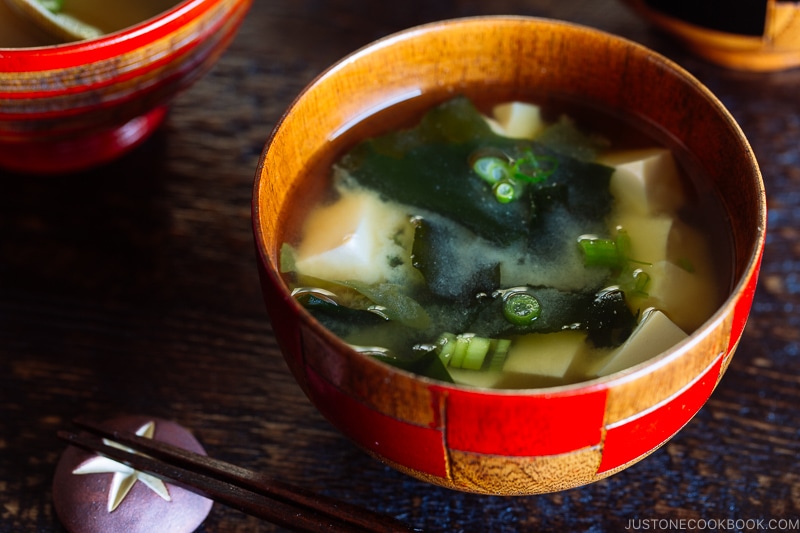
There’s nothing more comforting than starting the day with a warm bowl of miso soup. The common ingredients that go into miso soup include tofu, wakame seaweed, mushrooms, and green onions. You can change up the flavors and ingredients based on what you have in hand or what’s available in season.
- Miso Soup (your everyday soup)
- Kabocha Miso Soup
- Tonjiru (Pork and Vegetable Miso Soup)
- Kakitamajiru (Egg Drop Soup)
Grilled Fish 焼き魚
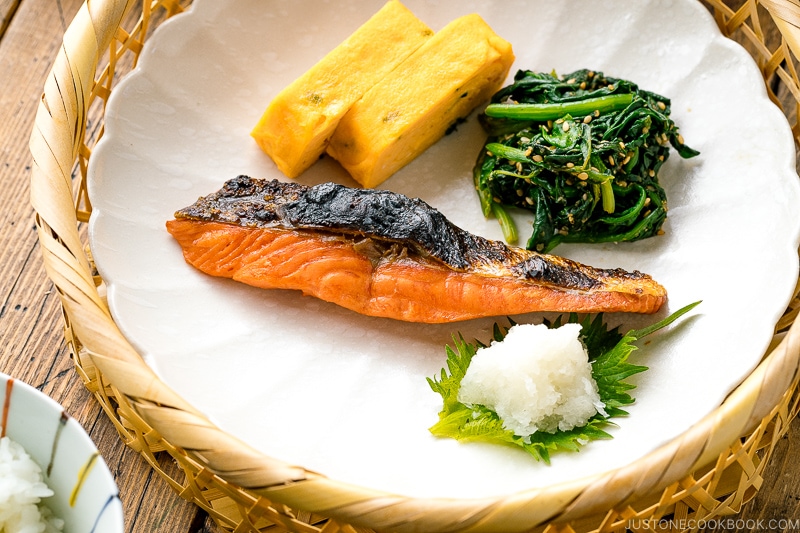
The main protein would be fish. Salted salmon and grilled mackerel are popular choices.
Egg Dish 卵焼き
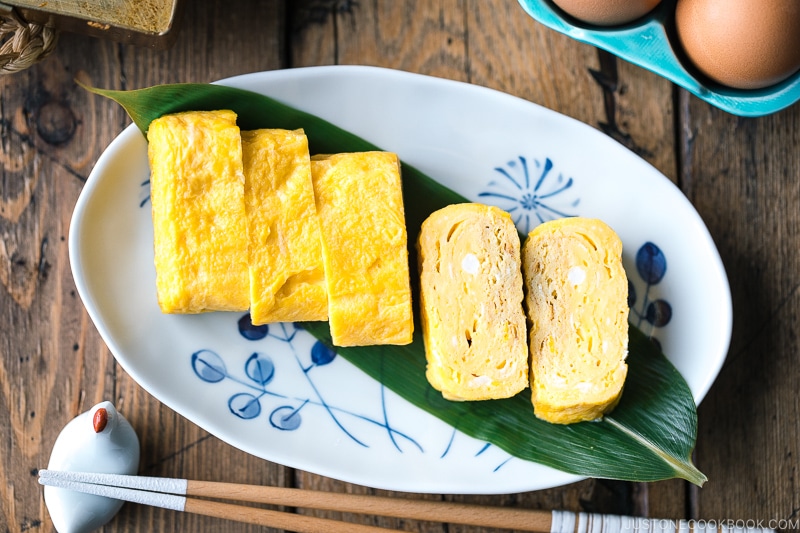
If you are skipping fish, eggs would be an excellent choice of protein. My absolute favorite egg dish is the sweet yet savory Tamagoyaki (Japanese Rolled Omelette). They are very popular with children. You don’t have to cook this right in the morning as that could be too much work! Tamagoyaki is a great freezer food, so make a big batch and reach for it when you serve a Japanese breakfast at home.
Vegetable Side Dish 小鉢
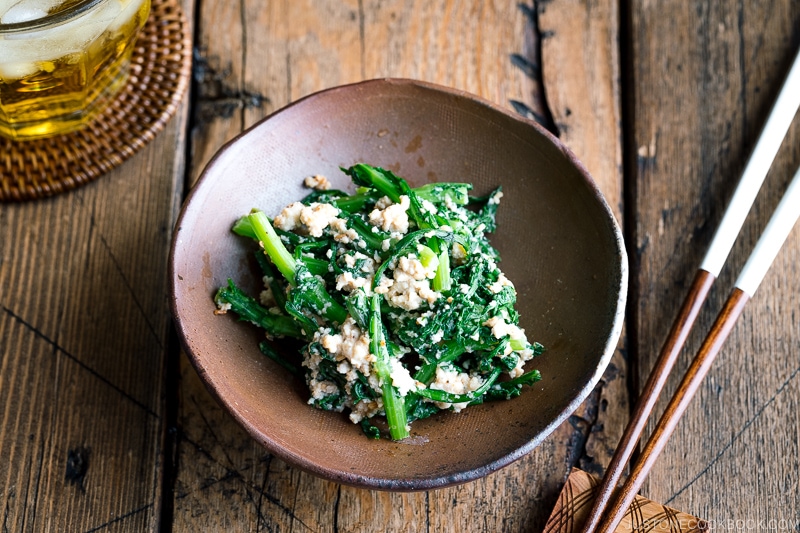
We all know that eating fiber-rich foods helps us stay full longer and improve health in general. So there’s always a vegetable side dish to complement the breakfast meal.
- Spinach Salad with Sesame Dressing
- Mashed Tofu Salad with Greens
- Green Bean Gomaae (Sesame Dressing)
- Blanched Broccoli with Sesame Oil
Pickled Vegetable (Tsukemono) 漬物
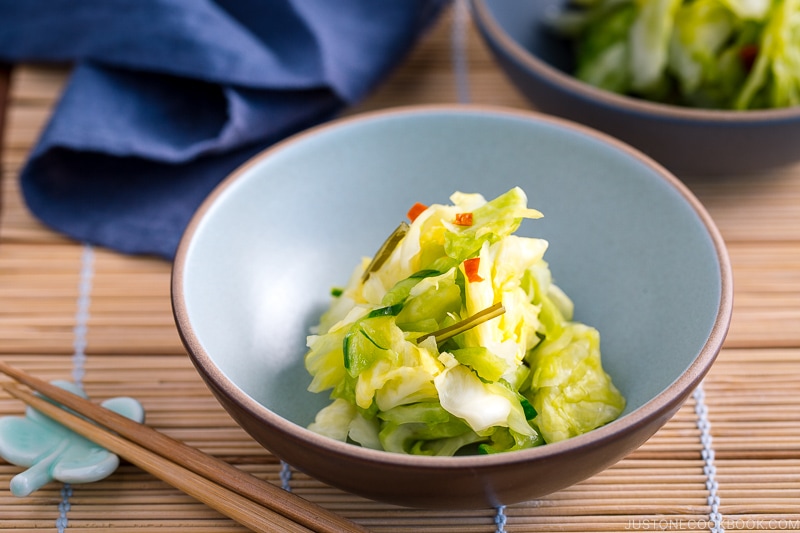
With a sweet, tangy and sour note, pickled vegetable stimulates the appetite, provides refreshment and enhance the overall flavors of the meal.
- Pickled Cucumbers
- Pickled Daikon
- Pickled Cabbage
- Pickled Daikon and Carrot with Sweet Vinegar
- 4 Easy Soy Sauce pickles
You can also buy pickled vegetables from the Japanese grocery store.
Seasoned Seaweed 味付け海苔
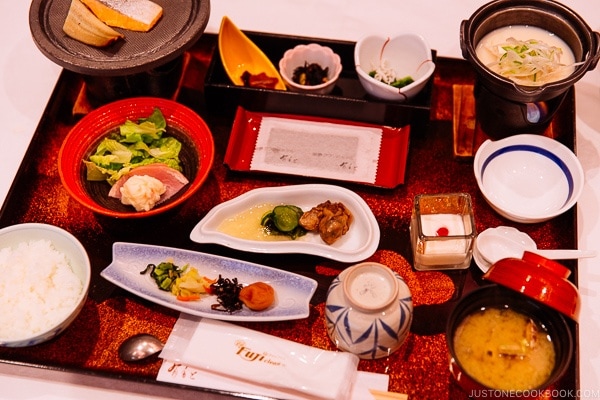
Dried and seasoned seaweed (ajitsuke nori) are also a staple of the breakfast menu.
You can purchase seasoned nori from Amazon. Don’t get a big container as nori easily gets stale fast.
Natto 納豆
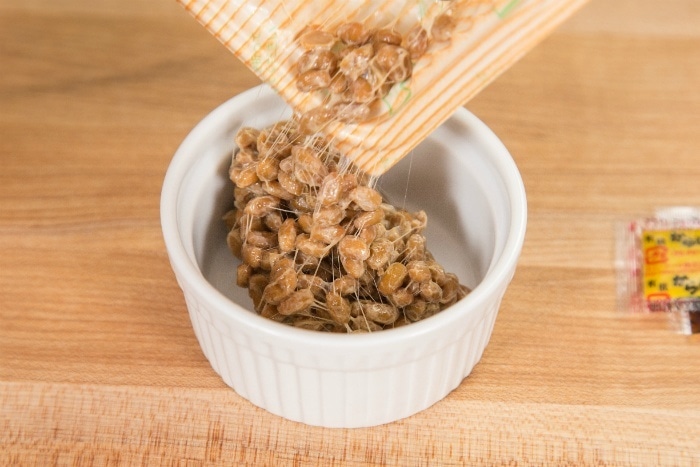
Lastly, fermented soybeans called natto is a breakfast favorite. This funky dish that graces the menu of a Japanese breakfast has an acquired taste, but the Japanese love it for many good reasons! Rich in protein, minerals, fiber, vitamin K2, and probiotics, natto is easily one of the best superfoods to eat.
You can buy prepackaged natto from the refrigerated or freezer section of Japanese or Asian grocery stores.
Green Tea 緑茶
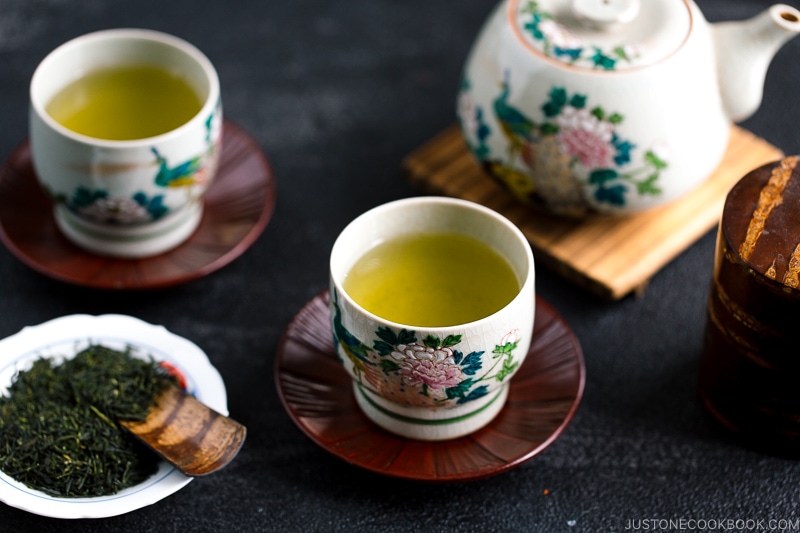
Serve hot green tea during or at the end of breakfast.
I hope this inspires you to make a traditional Japanese breakfast at home. Find a weekend, wake up a little early, and have a little fun in the kitchen! You and your loved ones would be so proud. And don’t forget to snap a picture of your breakfast spread, and share it with us on Instagram with the hashtag #justonecookbook!
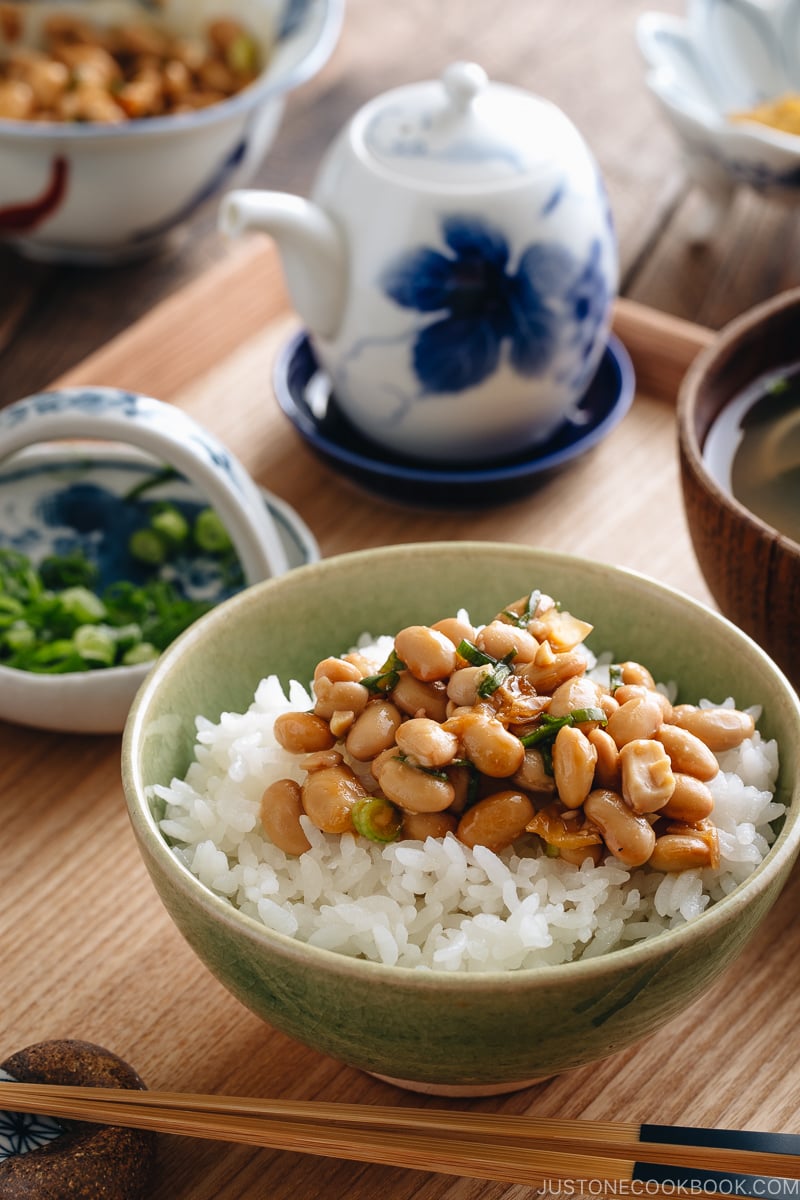
Where to Enjoy a Traditional Japanese Breakfast in Japan
Alternatively, you can also enjoy a traditional Japanese breakfast when you visit Japan at a ryokan (Japanese inn) or a hotel.
Most 3 to 5 Stars hotels offer a mix of Japanese and western breakfasts. Skip the usual waffles or pancakes, and allow yourself to indulge in a truly memorable breakfast experience!
Wish to learn more about Japanese cooking? Sign up for our free newsletter to receive cooking tips & recipe updates! And stay in touch with me on Facebook, Pinterest, YouTube, and Instagram.
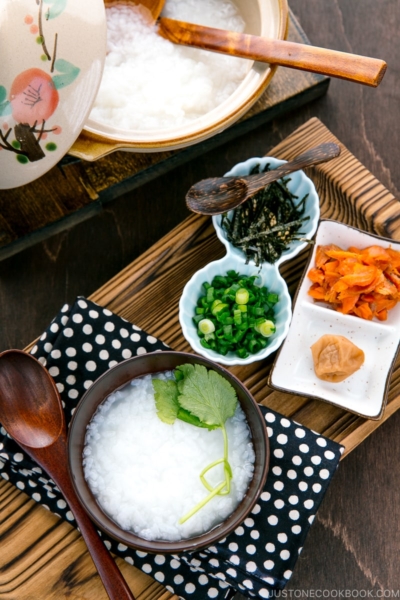
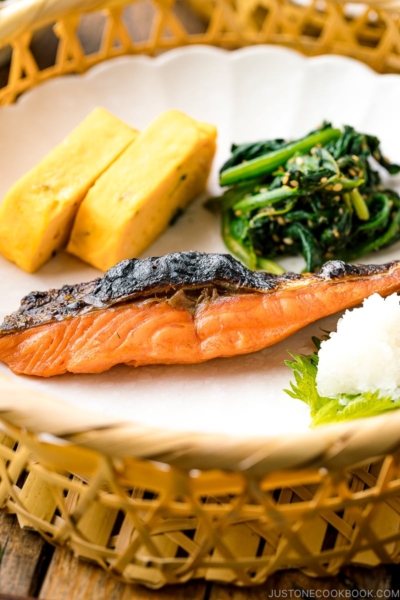
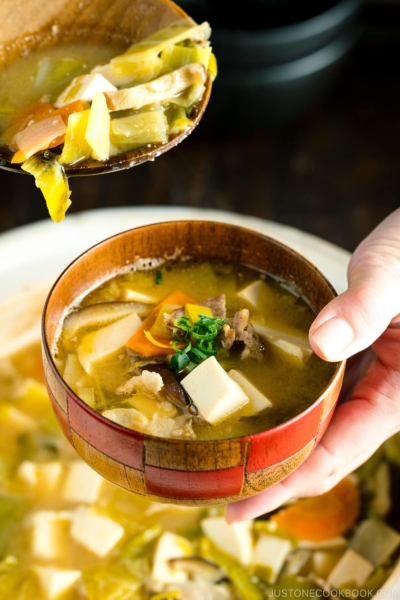
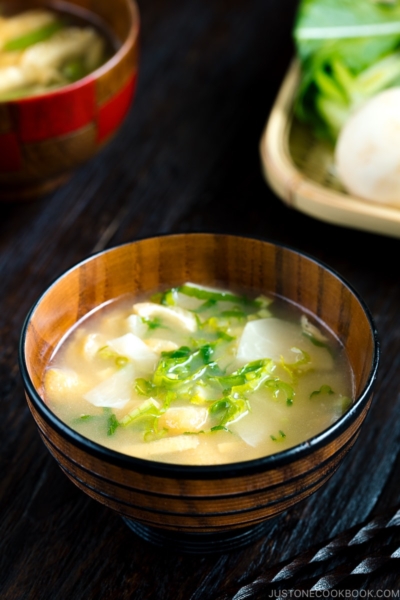
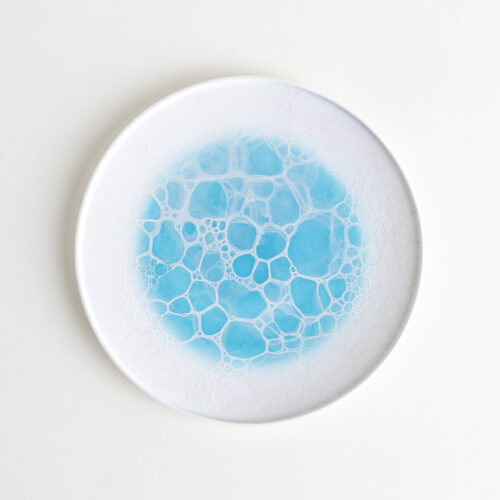
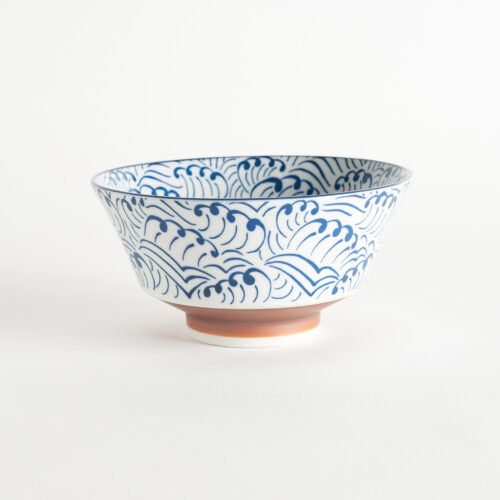

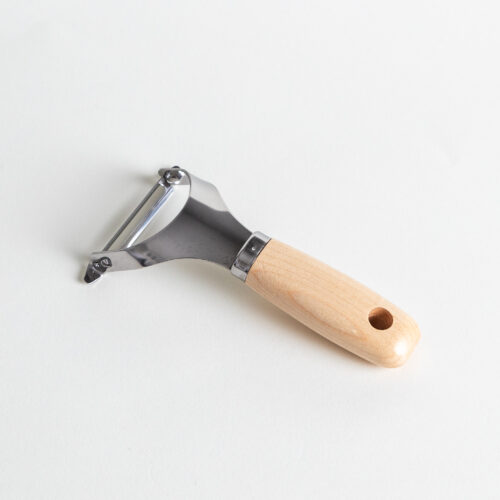
Hi! I love all the tips and recipes I find on here and they help me so much when I cook.
I recently found out I’m allergic to eggs! 😱😞 Is there anything I could substitute for the egg portion?
Also any tips on how to properly portion meals? I really struggle with portioning too much or too little.
Hi, Asuka! Thank you for reading Nami’s post and trying out her recipes.
You can either skip the egg dish or substitute it with another protein option when preparing a Japanese breakfast.🙂
Regarding meal portions, we recommend consulting with your dietitian, as everyone’s needs are different. We hope this helps!
Hi can I asked what you’re having for lunch if you’re eating this for breakfast? Or do you generally repeat the same sort of structure for all three meals? I’m interested in giving this a go so I’m
Curious about the rest of the day thanks ☺️
Hi, Heather! Thank you so much for reading Nami’s post!
Yes! We use the Ichiju Sansai method for all three meals. Even at school lunch! This post has further information on the subject.
https://www.justonecookbook.com/nutrition-and-food-education-in-japan/
We hope this helps!
Hi. I have been to Japan to ski many times and always have a traditional breakfast. They serve a small dish of a black seaweed that has a sweet soy taste. Do you recognise this and what would the name be.
Hello, Paula! Is the seaweed soft and pasty? It might be a Nori Tsukudani (海苔の佃煮).
It usually simmers the seaweed with Mirin, Sake, Sugar, and Soy sauce.
Nami has a similar recipe for Kombu Tsukudani. We hope this helps!
https://www.justonecookbook.com/simmered-kombu-tsukudani/
Hi question…I’m allergic to seaweed in any form drives me crazy as I live sushi etc is there anything I can use as a substitute for things like sushi or even as a side dish where seaweed would be used
Hi Marianne, Thank you for taking the time to read Nami’s post.
Depending on the recipe, you can leave out the seaweed.
For Sushi, how about using egg crepes instead of seaweed? https://www.justonecookbook.com/how-to-make-usuyaki-tamago-kinshi-tamago/
We hope this helps!
Sorry to barge in so uninvitedly, but how about soy paper?
https://ichisushi.com/what-is-soy-paper-for-sushi/
I like it just as much as nori.
Hi Nami, I went to Japan 5 years ago and loved the Japanese breakfasts in my kaiseki meals at ryokan stays. I also lost 9 pounds in the 3 weeks I spent there subsisting on a Japanese diet and doing a lot of walking. I read with interest your article on the traditional Japanese breakfast and would like to try to incorporate more fish, miso, fermented vegetables and rice into my breakfast routine. My question to you is how to cook mackerel? I didn’t see any instructional videos or recipes on your site. I once asked a Japanese friend about it and she was offended by the strong fish smell of mackerel so didn’t buy it. I don’t mind strong fish smells at all. I love all fish. I also wonder about the Japanese grilling technique where the fish is impaled vertically through its body and then charcoal roasted. I forget the name but it starts with an R. I’d love more technical tips on cooking fish for breakfast–also the perfect miso soup.
Hi Vicki! Thank you very much for reading Nami’s post and sharing your story with us!
We are very happy to hear you had a great time in Japan and that now you are interested in more Japanese breakfast and cooking techniques. You are in the right place, and we have everything here.🙂
Please click the red writing recipe names in this post. It will take you to each recipe with detailed instructions and photos.
Or click these links!
Grilled Mackerel:
https://www.justonecookbook.com/grilled-mackerel-saba-shioyaki/
Miso Soup:
https://www.justonecookbook.com/homemade-miso-soup/
As for the word stats with R., We think you are talking about Robatayaki. Here is a grilled vegetable version recipe, but you can grill fish and meat the same way.
https://www.justonecookbook.com/yakitori-style-grilled-vegetables
We hope this helps!
Hi Nami! My roommate is vegetarian, and I would like to substitute the fish for a main dish that isn’t egg-based, as I will be making tamagoyaki as a side dish. Do you have any recommendations for tofu or vegetable based main dishes?
Hi Olivia! Thank you very much for reading Nami’s post!
We have a vegetarian recipe list and this might be helpful:https://www.justonecookbook.com/tags/vegetarian/
You can also search your roommate’s favor from this link and use the recipe filter on the left to find it. https://www.justonecookbook.com/recipes/
Does your roommate like eggplant? How about this? https://www.justonecookbook.com/miso-glazed-eggplant/
We hope this helps!
LOVED making this at home. Reminded us of our trips to Japan, waking up in a Ryokan with snow outside. Oh Japan, can’t wait to go back!
Hi Pablo! Thank you for your feedback!
Yes! We can’t wait to revisit Japan too!😀
We have been having japanese breakfast for two months now and we find it very satisfying. It keeps us full way after lunch time so we eliminate the need for snacks. Plus we garden and I find japanese recipes are good way to use produce since you can easily substitute greens. I find this blog very useful and helpful in trying new recipes.At times when I know I am going to be busy at work and won’t have time to prepare fresh breakfast, I would meal prep the salmon (grill few of them and reheat them in the mornings), cook a bunch of greens (my favorite is daikon green furikake) that will last for several days and I even meal prep the miso soup – I just make sure that the miso soup will not boil will I reheat them the next day. So far it is working good. Thank you so much for this blog – it is a good source of information for me as I try to eat healthier.
Hi Adelfa! Awesome!! We couldn’t be happier to hear how much joy and excitement Nami’s recipe has brought to you!
Thank you very much for trying many recipes from our website and sharing your cooking experience with us. Thank you!🥰
I like your presentation of the Japanese breakfast. I am single (actually divorced) person and I find a lot of the recipes, here and elsewhere, are not meant for one person but rather for a large family. When I read those recipes, I become depressed because I cannot make them for myself. I don’t like to eat the same food for the entire week. Many of your recipe could be prepared for one person and I appreciate that. So my range of Japanese food is limited to a handful.
The recipes presented here are excellent and would love if I can try them. THANK you!
Hi Andrew! Thank you very much for reading Nami’s post!
Many dishes for Breakfast can be prepared ahead of time, and you can also freeze the leftover for another day.
Here is the post where Nami talks about freezing techniques.
https://www.justonecookbook.com/basic-freezing-techniques/
You can also make many recipes for one serving by changing the servings number in the recipe card!
We hope this is helpful, and we hope you enjoy many dishes from our website! Happy Cooking!😊
I always enjoy Japanese breakfast at hotels and yours looks soooo yummy. 🥰🥰🥰
Hi Joan! Thank you very much for your sweet comment! Nami is so happy to hear you enjoyed her Japanese breakfast menu.🥰
My husband and I love your recipes and we would love to incorporate the Japanese style breakfast into our morning routine when we can. Can you recommend the best way to prep these foods for an easy breakfast to come together? What are the best components to meal prep? If I use salmon that was flash frozen and thaw it, salt it and get it ready, I can’t refreeze the salmon for easy prep, correct?
Hi Christine! Thank you very much for reading Nami’s post.
Our recommendation is to prep the meal as much as you can ahead of time. For example, if you are using salmon, salt it and make it into a salted salmon and keep it in the refrigerator. https://www.justonecookbook.com/how-to-cook-salmon-salted-salmon/ or if you are using flash-frozen salmon and don’t want to marinade, thaw it overnight in the fridge to use in the morning. Yes. We do not recommend refreezing the salmon or any pre-frozen food.
To make miso soup, you can make a Dashi stock the night before and wash and cut vegetables for the morning, or you can make the miso soup without adding the miso to the soup and refrigerate, and the next day, warm them up and add the miso and serve.
Many side dishes can be made ahead of time and reheated if this works better for you. https://www.justonecookbook.com/categories/recipes/side/
We hope this is helpful, and you enjoy a Japanese breakfast!